|
|
|
Subspecies of Great Horned Owl in Ontario
by Ron Pittaway |
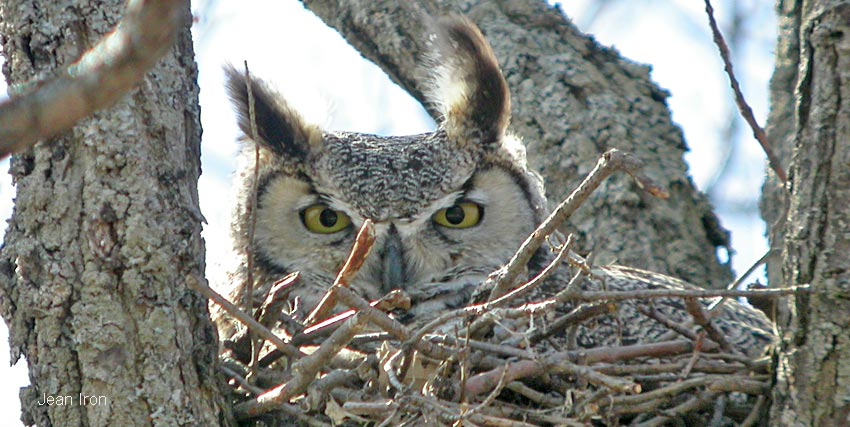 |
|
Snyder's Great Horned
Owl (scalariventris) on Manitoulin Island on 8 April 2006.
Digiscoped from public road. |
|
|
|
Revised January 2014.
First published
in Ontario Birds 11(2):64-69, August 1993. |
|
|
|
Introduction |
|
The Great Horned Owl (Bubo virginianus) is found throughout
most of Ontario,
north almost to Hudson Bay (James 1991). Its deep bass hooting, whoo,
hoo-hoo, whooo, whooo is a familiar night sound.
During the day, it often roosts in a secluded, thick evergreen and
most of the time would go undetected but for the keen eyesight of
its tormentor,
the American Crow (Corvus brachyrhynchos).
A flock of crows,
cawing loudly,
often betrays the presence of a roosting Great Horned Owl.
Getting a good look at resident birds in southern Ontario is
generally difficult because they are usually wary of humans.
However, the northern subspecies of the Great Horned Owl that wander
to southern Ontario in winter
are often less wary and more easily observed. Speirs (1985) noted
that the periodic movements of northern Great Horned Owls into
southern Ontario are associated
with population fluctuations in the Snowshoe Hare (Lepus
americanus).
However,
some (particularly young) may move south every winter (Houston
1978)
In this note,
I discuss the occurrence and identification of the subspecies of the Great Horned Owl in Ontario.
In addition,
this is the first time that a description and photograph appear in
the birding literature of the distinctive northern Ontario
subspecies B.
v.
scalariventris
(Snyder 1961).
See Figure 1. |
|
|
|
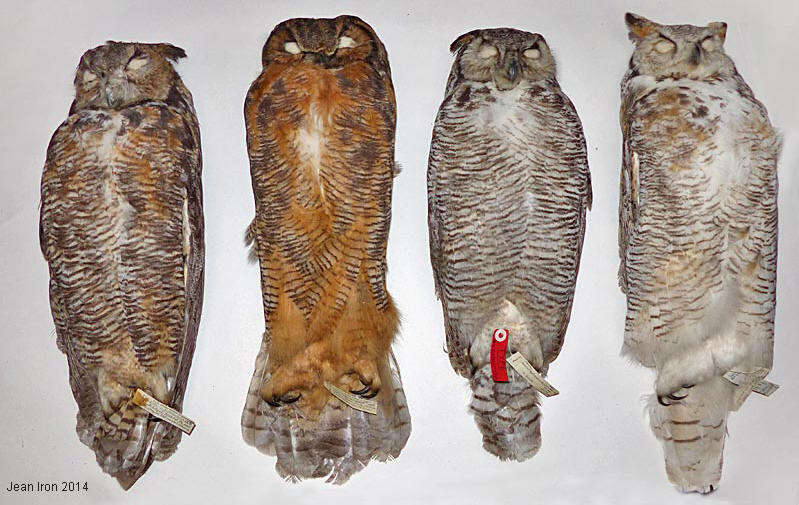 |
|
Figure 1. Four
subspecies of the Great Horned Owl: From left to right are Labrador Bubo
v. heterocnemis, Nominate B. v. virginianus, Snyder's B. v. scalariventris (type specimen) and
Arctic B. v. subarcticus in the Royal
Ontario Museum in Toronto on 21 January 2014. |
|
|
|
Taxonomy |
|
Geographical variation is pronounced in the Great Horned Owl. Here I
follow the treatment of James (1991) who lists four subspecies in
Ontario: the rufous nominate subspecies B.
v. virginianus
of southern Ontario; the grayish subspecies B. v.
scalariventris
of most of northern Ontario; the whitish subspecies B.
v.subarcticus
of extreme Western Ontario; and the blackish Labrador subspecies
B.
v. heterocnemis
which wanders to southern Ontario in winter.
James (1991) follows Snyder (1961) in treating B.
v. scalariventris
as a separate subspecies,
distinct from B.
v. subarcticus.
In April 1993,
I examined the large series of scalariventris
in the Royal Ontario Museum.
I believe that scalariveniris would be widely accepted as a
subspecies today if Snyder (1961) had published his
description in the more widely available Auk,
and before the American Ornithologists' Union (1957) last revised
its list of subspecies - now much in need of revision.
In the A.O.U Check-list (1957),
B.
v.
subarcticus
is listed as B.
v.
wapacuthu.
However,
the original description of wapacuthu
is confusing and cannot with
certainty
be associated
with
either the Great Horned Owl or Snowy
Owl (Bubo
scandiacus)
so
the name
wapacuthu
has
been discarded
(Manning
1952,
Todd 1963,
Browning
and Banks
1990, Dickerman 1991a). |
|
|
|
In addition, Godfrey (1966, 1986) noted
that the large series of pale Great Horned Owls in the Canadian
Museum of Nature from the southern parts of the Prairie Provinces
referred to B. v. occidentalis in the A.O.U. Check-list
(1957) "is not separable from subarcticus from farther
north". Dickerman (1991b) also concluded that occidentalis
should be synonymous with subarcticus. See the comments on
subspecies on page 310 in Godfrey (1986) and pages 48, 91 and 92 in
James (1991). |
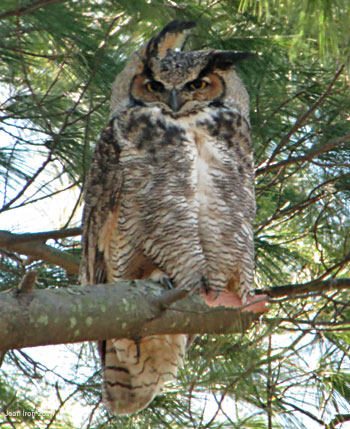 |
|
|
|
Plumages |
|
The sexes of the Great Horned Owl are similar in appearance,
except that females average larger than males.
First year birds and adults are similar in coloration.
“The
downy young moult directly into the colors of the adults”
(Taverner 1942). |
|
|
|
"Nominate" Great Horned Owl (B.
v.
virginianus) |
|
The nominate subspecies breeds in southern Ontario (James 1991).
It
is
usually a permanent resident being less prone
to wander than the northern subspecies.
It is distinguished
from
the northern
subspecies
by
its
"medium
dark coloration
with
distinctive
amount of redness in the
plumage" (Godfrey
1986).
Some are quite rufous as shown in Figure 1.
As well,
the
black rimmed facial
discs
are
usually
a
clear
rusty
colour
(Taverner
1942). A typical
individual
of
this
southern
subspecies is illustrated by John Crosby
on Plate 42 in The
Birds
of
Canada
(Godfrey
1986). |
|
|
Figure 2. Nominate Great Horned Owl
(virginianus)
at Thickson's Woods, Ontario, 20 May 2014. |
|
"Snyder's" Great Horned Owl (B. v.
scalariventris) |
|
L.L.
Snyder (1961) of the Royal
Ontario Museum described the
population of pale Great Horned Owls breeding in most of northern
Ontario (except extreme
western parts) as distinct from B.
v. subarcticus,
and named it B.
v.
scalariventris,
which means scaly below.
See Figure 1.
Taverner (1942) was aware of this form,
stating that it was
“too
dark for subarcticus,
too white for any other race
...
with little or no red of virginianus.”
He regarded it as an intergrade population of subarcticus x
heterocnemis. However,
the large and uniform series of scalariventris
in the Royal Ontario Museum from across 800 km of northern Ontario
strongly supports its recognition as a separate subspecies
(Snyder 1961).
Consequently,
James (1991) accepted scalariventris
as a subspecies.
Snyder's Great Horned Owl breeds in northern Ontario from near the
Manitoba border eastward to the Quebec border (and probably beyond),
south to approximately Thunder Bay,
Sault Ste. Marie and North Bay, where it intergrades with nominate
virginianus (Snyder 1961,
James 1991).
In winter it wanders to southern Ontario.
Most reports of pale (gray) Great Horned Owls in southern Ontario
are referable
to scalariventris.
Classic
individuals of
scalariventris
(Figure 3)
are distinguished
from nominate
virginianus
by
their distinctive gray coloration and general absence of rufous
in
the
plumage.
The facial
discs
are
usually
a pale gray, sometimes
with
a tinge
of
rufous.
From the more
whitish subarcticus, Snyder's
is
told
by
its
darker coloration and
“broader,
more
regular and darker bars ventrally.”
In broad terms,
scalariventris
is
“more
coldly grey with
bolder
bars below”
(Snyder 1961). |
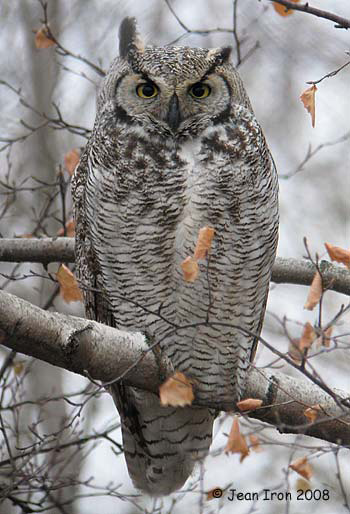 |
|
|
Figure 3. Snyder`s Great Horned Owl
(scalariventris)
in Toronto on 14 December 2008. |
|
“Arctic” Great Horned Owl (B.
v. subarcticus) |
|
|
The Arctic subspecies breeds east of the Rocky Mountains,
across the boreal forest and prairies to northern Ontario (Godfrey
1986).
However,
Snyder (1961) considered most of the northern Ontario population to
be
distinct from
subarcticus
and designated it
as a separate subspecies,
scalariventris.
See Figure 3 and previous account
of that subspecies.
James
(1991)
stated that subarcticus
breeds
along
the western fringe of
the province
where it intergrades with scalariventris.
The Arctic subspecies (subarcticus) wanders
elsewhere throughout
the
province
(Taverner
1942),
including
specimens from near Algonquin Park (Tozer 2012) and Toronto,
but it is very much rarer in southern Ontario than the Snyder's
subspecies (scalariventris).
Classic examples of subarcticus
as in Figure 1
are much more extensively
white
than scalariventris,
“with
more
vague
and sparse dark markings below”
(Snyder 1961).
The facial discs
are
“white
to
light ashy,
rarely
with
a
tinge of
rufous”
(Taverner
1942).
Illustrations of the Arctic
subspecies
appear
on page 239 of the National
Geographic
Guide
(Dunn and Alderfer 2011),
on
Plate
32 in Birds
of
Canada
(Taverner
1937),
and
on page 232 of
Peterson’s
Field
Guide
to the Birds of North America
(2008).
See Figure
4.
Occasionally
a very
whitish
Great
Horned
Owl
as in Figure 4
is sighted, almost
as white
as
a dark
Snowy
Owl.
Such
birds
are safely
called
subarcticus.
However,
keep
in
mind
that most
pale
birds
seen
in
Ontario
are referable
to scalariventris. |
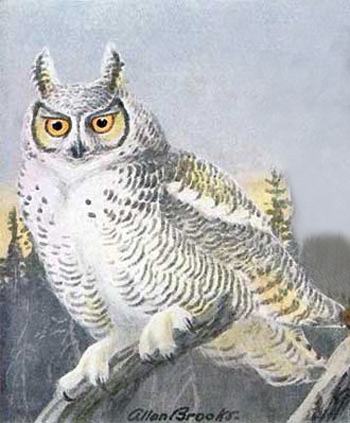 |
|
|
Figure 4. Arctic Great Horned Owl (subarcticus) by Allan Brooks
in the Birds of Canada (Taverner 1937). |
|
“Labrador” Great Horned Owl
(B. v. heterocnemis) |
|
|
The
dark
Labrador
subspecies
breeds
in Newfoundland
and
Labrador
south
to central Quebec
(Godfrey
1986).
In winter heterocnemis
wanders
to southern
Ontario
(James
1991).
Taverner
(1942) listed
specimens
from
Ottawa,
Peterborough
County,
Peel Region,
Toronto
and
St.
Thomas.
I saw
a
“Labrador”
Great
Horned
Owl at Aylmer,
Quebec,
near
Ottawa
one
winter
when
I
was a
teenager.
It was tame
(unlike
most
of the
local
birds) and allowed
me
to observe
it closely.
I
identified
it
from
the
description
in the
subspecies
section
of
the
old
Peterson's
Field
Guide
(Peterson 1947)
which
is
still
a useful
reference
on
subspecies.
The Labrador subspecies differs from the nominate subspecies by its
much darker (sootier) coloration and heavier barring below. On
classic individuals, “the barring often obliterates the white
markings, giving a black breasted appearance” (Peterson 1947). In
addition, the facial discs are usually a dark brownish-gray instead
of a clear rusty as in the nominate subspecies. |
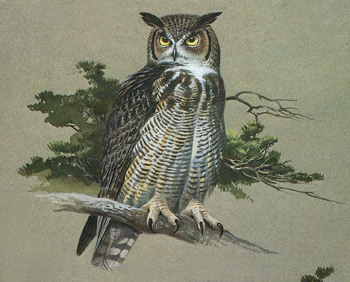 |
|
|
Figure 5.
Labrador Great Horned Owl (heterocnemis)
by Roger Tory Peterson in
The Birds
of Newfoundland
(Peters and
Burleigh
1951). |
|
Summary
|
|
Four
subspecies
of the
Great
Horned
Owl
are found
in Ontario.
Although
intergrades
occur,
typical
individuals
of
these subspecies
are identifiable in
the field.
The
type specimen of “Snyder's”
subspecies
B.
v.
scalariveniris
is shown and described
here in
the birding
literature
for the first
time.
This
cold gray
subspecies accounts
for most of the reports
of pale Great Horned
Owls seen in Ontario.
|
|
|
|
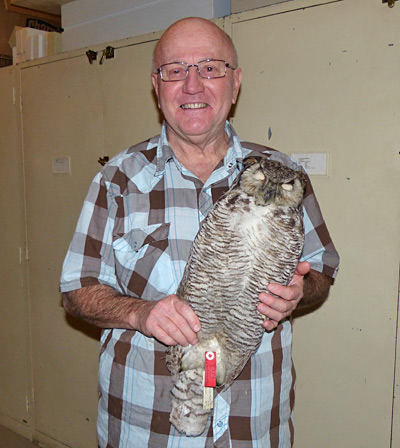 |
|
Ron Pittaway
holds the type specimen of Snyder`s Great Horned Owl (Bubo
virginianus scalariventris) collected in Elsas, Algoma
District, Ontario, 26 February 1948. Jean Iron and I visited the
Royal Ontario Museum on 21 January 2014 to check Great Horned Owl
specimens and revise my original article published in
August 1993 in Ontario Birds 11(2):64-69. |
|
|
|
Acknowledgements |
|
I thank Bill
Crins,
the late Earl
Godfrey, Michel
Gosselin of the Canadian Museum of
Nature,
Phill
Holder,
Ross
James,
Mike
King,
Ron
Tozer
and
Mike
Turner for
much
valuable
advice
in the
preparation
of this note.
Ross
James,
Jim
Dick
and Mark Peck
kindly
allowed
me and Jean to examine
skins in
the
Royal
Ontario
Museum.
Jean Iron's colour photographs greatly enhance this revised version. |
|
|
|
Literature Cited |
|
American
Ornithologists'
Union.
1957.
Check-
list
of North
American
Birds, 5th
edition.
American
Ornithologists'
Union,
Washington,
D.C.
Bent,
A.C.
1938.
Life
Histories
of North
American
Birds
of Prey.
Part
2.
United
States
National
Museum
Bulletin
170.
Washington,
D.C.
Browning,
M.R.
and R.E.
Banks.
1990.
The
identification
of
Pennant's
“Wapacuthu
Owl”
and the
subspecies
name
for the
population
of
Bubo
virginianus from
the western
Hudson
Bay.
Journal
of
Raptor
Research
24:
80-83.
Dickerman,
R.
W.
1991a.
Specimens
of the
subarctic
nesting
populations
of Great
Horned
Owls
from
New
York,
New
Jersey
and Connecticut.
Kingbird
41:
154·157.
Dickerman,
R. W.
1991b.
On the
validity
of
Bubo virginianus occidentalis Stone.
Auk 108:
964-965.
Dunn, J.L. and J. Alderfer 2011.
Field Guide to the Birds of North America. National Geographic
Society, Washington, D.C.
Godfrey,
W.E.
1966.
The
Birds
of Canada.
National Museum
of
Canada
Bulletin
203.
Godfrey,
W.E.
1986. The
Birds of Canada.Second
Edition.
National
Museum
of Canada,
Ottawa.
Houston, C.S.
1978. Recoveries of Saskatchewan-banded Great Horned Owls. Canadian
Field-Naturalist 92: 61·62.
James, R.D.
1991. Annotated Checklist of the Birds of Ontario. Second Edition.
Life Sciences Miscellaneous Publications, Royal Ontario Museum,
Toronto.
Manning, T.H.
1952. Birds of the west James Bay and southern Hudson Bay coast.
National Museum of Canada Bulletin 125: 1·114.
Peters,
H.S. and T.D.
Burleigh,
1951.
The
Birds
of Newfoundland.
Department
of
Natural
Resources,
St.
John's.
Peterson,
R.
T.
1947.
A Field Guide to
the Birds.
Houghton
Mifflin Company,
Boston.
Peterson, R.T.
2008. Field Guide to the Birds of North America. Houghton Mifflin
Company, Boston.
Snyder,
L.L.
1961.
On an unnamed
population
of the
Great
Horned
Owl.
Life
Sciences
Division,
Royal
Ontario
Museum,
Contribution
No.
54:
1-7.
Speirs, J.M.
1985. Birds of Ontario. Volume 2. Natural Heritage/Natural History
Press, Toronto.
Taverner, P.A.
1937. Birds of Canada. The National Museum of Canada, Ottawa.
Taverner, P.A.
1942. Canadian races of the Great Horned Owls. Auk 59: 234-245.
Todd,
W.E.C.
1963.
Birds
of the
Labrador
Peninsula
and
Adjacent Areas.
Carnegie
Museum
and University
of Toronto
Press.
Tozer, R. 2012. Birds of Algonquin Park. The Friends of
Algonquin Park, Whitney, Ontario. |
|
|
|
Ron
Pittaway, 9 Lichen Place, Toronto ON M3A 1X3 or email:
jeaniron@sympatico.ca |
 |
|
Great Horned Owl in
Toronto on 14 December 2008 |
|
|
|
|
|